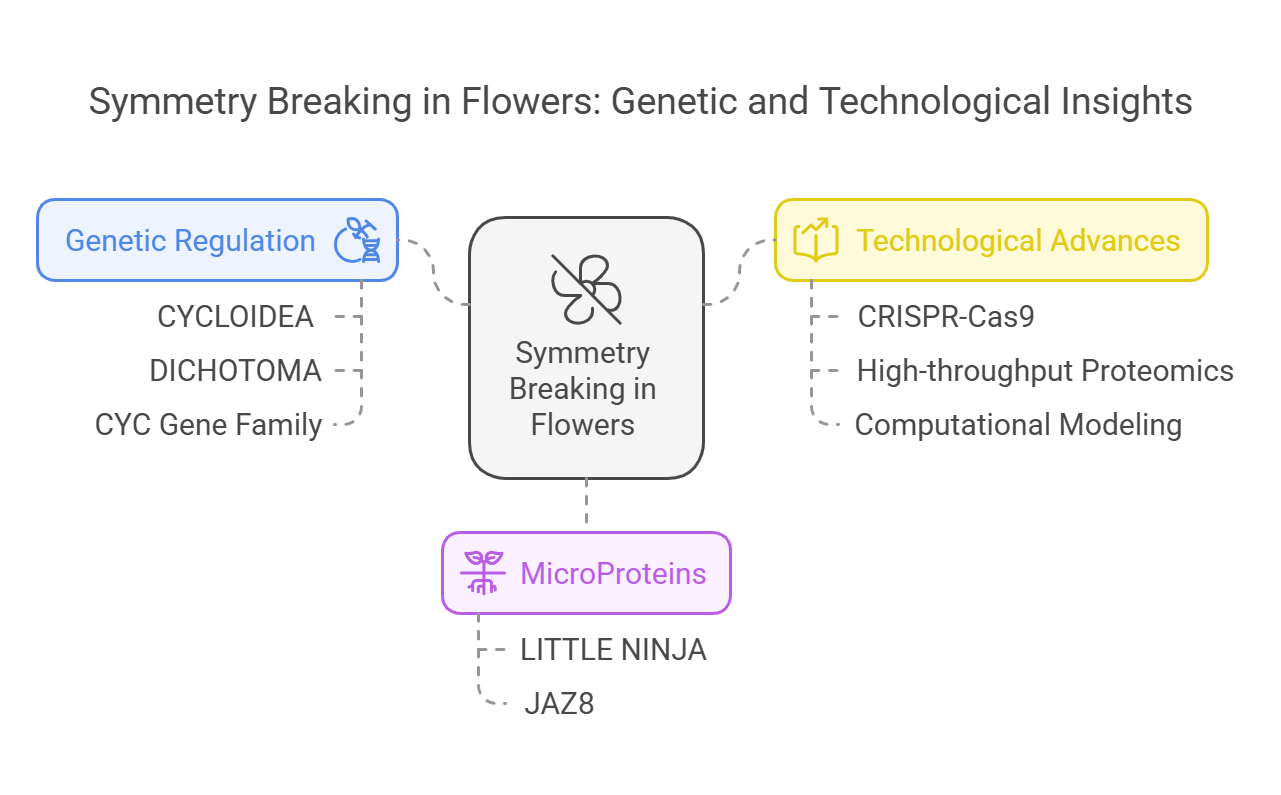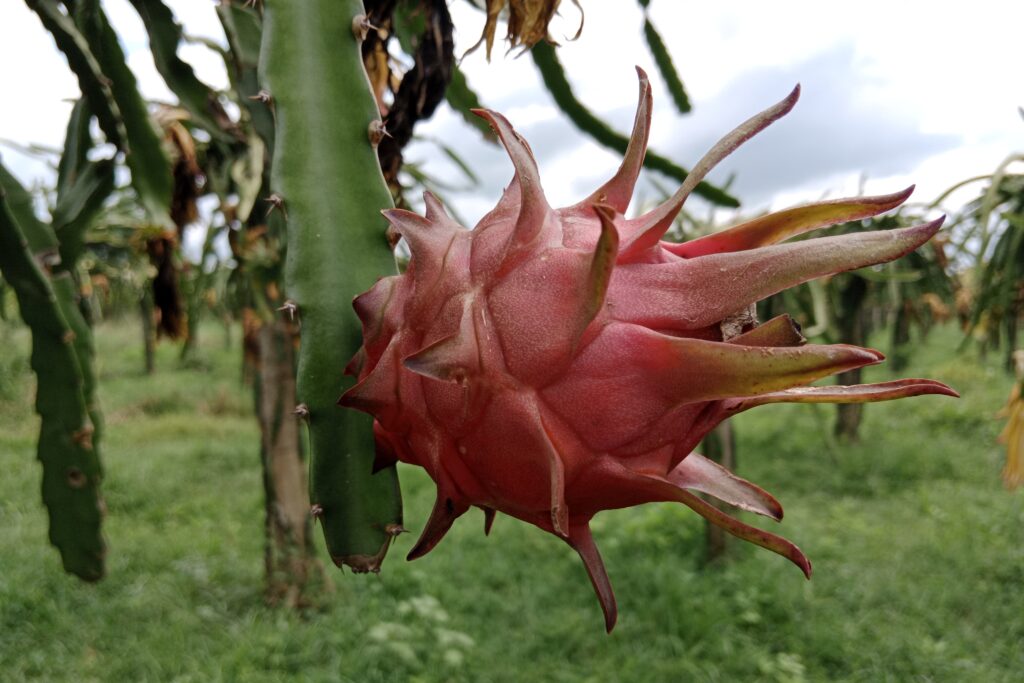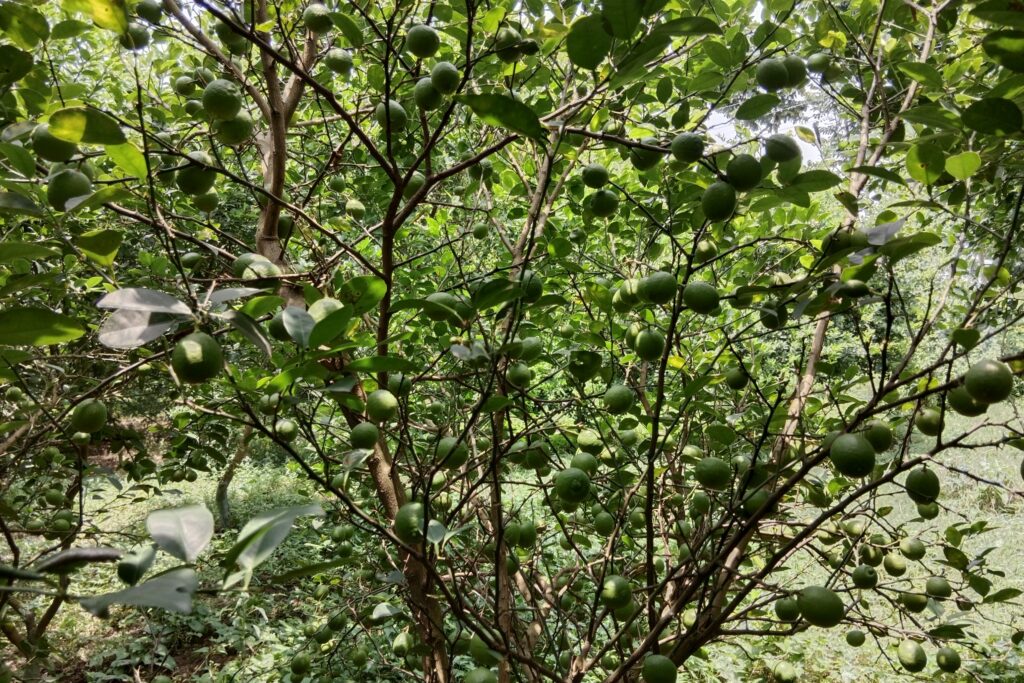Introduction
Symmetry breaking is a fundamental biological process that drives the development of complex structures from initial symmetrical forms. In plants, this phenomenon is particularly evident during flower development, where radial symmetry (actinomorphy) or bilateral symmetry (zygomorphy) emerges, contributing to the vast diversity of floral forms observed in nature (Coen & Meyerowitz, 1991). Understanding the molecular mechanisms underlying symmetry breaking is crucial for unraveling the evolutionary and developmental processes that shape plant morphology.
Recent studies have highlighted the role of small proteins, particularly microProteins, as key regulators of plant development. MicroProteins are small, single-domain proteins that modulate the activity of larger protein complexes, often through competitive inhibition or stabilization (Eguen et al., 2015). Despite their small size, these proteins play significant roles in developmental processes, including flowering, leaf patterning, and stress responses. However, their specific involvement in symmetry-breaking processes during flower development remains poorly understood.
This study about plant science with a focus on small proteins aims to bridge the knowledge gap by investigating the molecular mechanisms of symmetry breaking in flowers, with a focus on identifying and characterizing small proteins, including microProteins, that regulate this process. By combining experimental and computational approaches, this research will provide novel insights into the role of small proteins in plant development and contribute to a deeper understanding of the evolutionary principles governing floral diversity.
Literature Review
Symmetry breaking in flowers has been extensively studied in model organisms such as Arabidopsis thaliana and Antirrhinum majus. In Arabidopsis, the establishment of floral symmetry involves the interplay of transcription factors, such as CYCLOIDEA (CYC) and DICHOTOMA (DICH), which promote bilateral symmetry (Luo et al., 1996). Similarly, in Antirrhinum, the CYC gene family plays a central role in controlling zygomorphy (Luo et al., 1999). These studies have established a foundational understanding of the genetic regulation of floral symmetry.

Small proteins, particularly microProteins, have emerged as critical regulators of plant development. For instance, the microProtein LITTLE NINJA (LNI) has been shown to regulate jasmonate signaling, influencing plant growth and defense responses (Hong, Y.S., 2020). Another example is JAZ8, a small protein that modulates jasmonate signaling by interacting with larger protein complexes (Shyu et al., 2012). Despite these advances, the role of microProteins in floral symmetry breaking remains unexplored.
Recent advances in genomics, proteomics, and genome editing have provided powerful tools for studying plant development. For example, CRISPR-Cas9-mediated genome editing has enabled precise manipulation of genes involved in flower development (Wang et al., 2016). Similarly, high-throughput proteomics has facilitated the identification of protein-protein interactions and post-translational modifications that regulate developmental processes (Smakowska-Luzan et al., 2018). These technologies, combined with computational modeling, offer unprecedented opportunities to dissect the molecular mechanisms underlying symmetry breaking in flowers.
Also Read About: Developmental Adoption for Plant growth in soils: regulated by protein kinase AGC1.
Research Gap
While significant progress has been made in understanding the genetic regulation of floral symmetry, the role of small proteins, particularly microProteins, in this process remains largely unexplored. Current studies have focused primarily on transcription factors and signaling pathways, with limited attention given to the regulatory functions of small proteins. Additionally, the integration of experimental and computational approaches to study symmetry breaking in flowers is still in its infancy. This project seeks to address these gaps by:
- Identifying and characterizing small proteins involved in symmetry-breaking processes during flower development.
- Developing predictive models to elucidate the regulatory networks governing floral symmetry.
Hypothesis
We hypothesize that small proteins, including microProteins, play a critical role in regulating symmetry-breaking processes during flower development by modulating the activity of larger protein complexes and signaling pathways.
Objectives
- Identify small proteins, including microProteins, that are differentially expressed during symmetry-breaking processes in flowers.
- Characterize the functional roles of selected small proteins in regulating floral symmetry using genetic and biochemical approaches.
- Develop computational models to predict the regulatory networks involving small proteins in flower development.
- Validate the predictive models using experimental data and refine the models to improve their accuracy.
Materials and Methods
Plant Material and Growth Conditions
- Model plants such as Arabidopsis thaliana and Antirrhinum majus will be used for this study.
- Plants will be grown under controlled environmental conditions (16-hour light/8-hour dark cycle, 22°C).
Identification of Small Proteins
- RNA sequencing (RNA-seq) will be performed on floral tissues at different developmental stages to identify differentially expressed small proteins.
- Proteomic analysis using liquid chromatography-tandem mass spectrometry (LC-MS/MS) will be conducted to identify small proteins and their post-translational modifications.
Functional Characterization
- CRISPR-Cas9-mediated genome editing will be used to generate knockout mutants of selected small proteins.
- Overexpression and knockdown lines will be created to study the effects of small proteins on floral symmetry.
- Protein-protein interactions will be analyzed using yeast two-hybrid assays and co-immunoprecipitation (Co-IP).
Computational Modeling
- Mathematical models will be developed to simulate the regulatory networks involving small proteins in flower development.
- Machine learning algorithms will be employed to analyze large-scale datasets and predict the roles of small proteins in symmetry breaking.
Data Integration and Validation
- Experimental data will be integrated with computational models to validate predictions.
- Models will be refined iteratively based on experimental results.
Expected Outcomes
- Identification of novel small proteins involved symmetrical-breaking processes during flower development.
- Characterization of the functional roles of these proteins in regulating floral symmetry.
- Development of predictive models that provide insights into the regulatory networks governing flower development.
- Publication of research findings in high-impact journals and presentations at international conferences.
- References
- Coen, E. S., & Meyerowitz, E. M. (1991). The war of the whorls: genetic interactions controlling flower development. Nature, 353(6339), 31-37.
- Eguen, T. E., Straub, D., Graeff, M., & Wenkel, S. (2015). MicroProteins: small size—big impact. Trends in Plant Science, 20(8), 477-482.
- Hong, Y.S. et al., (2020). Heterologous microProtein expression identifies LITTLE NINJA, a dominant regulator of jasmonic acid signaling. PNAS, 117 (42) 26197-26205.
- Luo, D., Carpenter, R., Vincent, C., Copsey, L., & Coen, E. (1996). Origin of floral asymmetry in Antirrhinum. Nature, 383(6603), 794-799.
- Shyu, C., et al. (2012). JAZ8 Lacks a Canonical Degron and Has an EAR Motif That Mediates Transcriptional Repression of Jasmonate Responses in Arabidopsi. The Plant Cell, 24(2), 536-550.
- Smakowska-Luzan, E., Mott, G., Parys, K. et al. An extracellular network of Arabidopsis leucine-rich repeat receptor kinases. Nature 553, 342–346 (2018).
- Wang, Y., Cheng, X., Shan, Q., Zhang, Y., Liu, J., Gao, C., & Qiu, J. L. (2014). Simultaneous editing of three homoeoalleles in hexaploid bread wheat confers heritable resistance to powdery mildew. Nature Biotechnology, 34(5), 529-532.
- Wu, Q., Zhong, S., & Shi, H. (2022). MicroProteins: Dynamic and accurate regulation of protein activity. Journal of Integrated Plant Biology. 64(4), 812-820.



Pingback: Role of RNA Capping in Regulation of E. coli Metabolism -